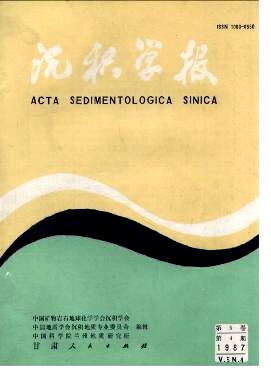ON SYNGENESIS, DIAGENESIS, ANADIAGENESIS AND SUPERGENE ALTERATION OF TRIASSIC GYPSUM SALT IN QUXIAN, SICHUAN
- Received Date: 1985-08-19
- Publish Date: 1987-12-10
Abstract: A series of changes take place during each of stages after sedimentation of gypsum-salt. Researches on these changes are of significance, which are helpful not only to the analyses of depositional condition but also to the determination of prospecting criteria and the evaluation of potentiality. This paper mainly involves investigations on such problems as the syngenesis, diagenesis, anadiagenesis and supergene alteration of Triassic gypsum-salt in Quxian County, Sichuan Province. Some carbonates, such as dolomite and magnesite, are a associated minerals of the Triassic evaporite which chiefly contains gypsum, anhydrite and polyhalite. Observations in detail find out that some anhydrites taking the pseudomorph after idiomorphic crystals of gypsum reserve the syndepositional zoning of gypsum, it means that the syngenetic CaSO4 mineral is gypsum. The sedimentary environment of gypsum-salt in this region may be deduced from various date about sedimentary condition of the syngenetic gypsum and anhydrite and from the results of sedimentary facies analysis. During of syngenesis, calcite associated with gypsum was replaced by Mg-rich brine and changed into micritic dolomite with the brine became more concentrated, and while CO32-rich fresh water supplemented gypsum also would be replaced by dolomite owing to the raise of pH value and the existence of organism. At this stage, fresh water flowing into the basin might leach the former dissolvable salt and formed K-Mg-rich solution which might replace the gypsum of surface bed and promote the formation of thin-lagyr polyhalite interbeding with gypsum, mud and magnesite so that made up laminated structure. At the early period of diagenesis, as a result of the replacement of lime-mud matrix by Mg-rich pore brine, fine crystal dolomite occured and disseminated dissolvable salt minerals precipited in the interspace of gypsum. With the increase in depth of burial of sediments, gypsum dehydrated into anhydrite because of the raise of temperature and pressure. The anhydrite of filling type was formed while released solution. Containing a portion of CaSO4, went through diagenetic cracks. At the period of diagenesis, pore brine must have replaced carbonate to form nodular anhydrite, the characters of which, such as ellipsoidal shap, uniform size and directive distribution along layer, are as distinct form that of the cave filling and Sabkha replacement anhydrite. Moreover, unregular, veined and massire polyhatite, on which the replacement remanent texture of anhydrite can be watched,was formed below the surface sediments due to the infiltrate metasomatism by K-Mg-rich solution formed by leaching of dissolvable salt. At the period of supergene alteration changes more intense than at any other stages further are taken place in the gypsum-salt, because of the leaching process of sub-and-surface water. First and foremost, anhydrite hydrated into gypsum and associated dolomite was replaced with calcite, and with that dissolution-collapse breccia occured due to the collapse of its distal wall and intercalated bed after dissolution of gypsum-salt layer. This breccia is of complex composition and wide brecciated size range the fragments are cemented by secondary calcite and filled by mud. If these rocks cracked into fragments due to differential plastic deformation or tectonic strain, then the gypsum-salt among the fragments desolved and the fragments cemented by secondary calcite and filled by mud, so the crushed-desolved breccia would be formed. These breccias characterised by that the fragments arranged follow the stratification plane without obvious displacement and showed deformational structures. Finally, degypsification happened, i, e., both surface water and shallow-subsurface water bearing great quantities of HCO3- replaced anhydrite into calcite. Gypsum in the interspace of crush breccia of dolomite was replaced by secondary calcite to form crushing-replacement breccia. Research on various changes of gypsum-salt after its sedimentation is an important aspect of changes taken place investigation for salt deposit. For instaace,in the light of its during the syngenesis and diagenesis, one debate its sedimentary condition and saltness of brine at that time, and according to the eztent of its supergene alteration,combining with the analyses of tectonic,and caver canditions,one also canon,geollogists working determine the region favourable forhydrogeo logicalits reservation.From now work.on salt deposit should pay more attentions to this work.
| Citation: | Wei Heming. ON SYNGENESIS, DIAGENESIS, ANADIAGENESIS AND SUPERGENE ALTERATION OF TRIASSIC GYPSUM SALT IN QUXIAN, SICHUAN[J]. Acta Sedimentologica Sinica, 1987, 5(4): 56-65. |






 DownLoad:
DownLoad: